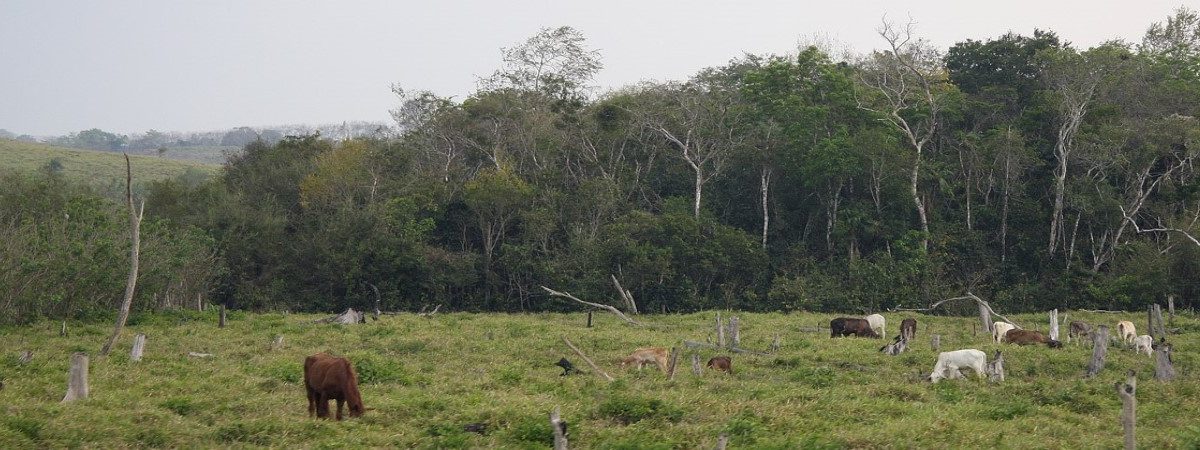- Guatemala wants to continue to export cattle to Mexico but needs to regulate the industry to prevent the deforestation of the Mayan Biosphere Reserve and other protected forests.
- The government is constructing new cattle pen facilities on the border that could convince more ranchers to participate in a legal traceability system.
- However, even if the traceability system improves, deforestation caused by drug traffickers and other criminal actors will likely persist.
Guatemala is getting ready to implement new regulatory programs for the cattle industry in hopes of slowing the rate of deforestation in some of the country’s most at-risk tropical forests.
The government has invested in quarantine pens for cattle raised in Petén, a department that has struggled to prevent cattle ranching from encroaching on the 2-million-hectare (5.2-million-acre) Mayan Biosphere Reserve.
The pens are being built on the border town of El Ceibo, one of the area’s only formal crossing points into Mexico, with the goal of better monitoring the thousands of cattle that are exported from Guatemala each year.
Most of Petén, especially along the border, is uninhabited forest without formal roads, making it easy for cattle ranchers operating illegally within the reserve to use hidden routes for smuggling animals into rural Mexico, where many are subsequently “laundered” into legal herds.
This year, Guatemala has exported nearly 7,000 head of cattle to Mexico, generating around $3.5 million, according to the Ministry of Agriculture, Livestock and Food. In the last few years, the industry has also become Guatemala’s fifth-largest export to the U.S., according to the USDA.
“The government is looking for a way to do this in a sustainable way,” said Luis Fernando Guerra, a veterinarian field coordinator for the Wildlife Conservation Society in Guatemala. “It is realizing that it’s the only way to be competitive in a world where cattle ranching has such a large environmental impact.”
Until recently, veterinarians in Guatemala have had to travel to each cattle ranch in Petén to carry out sanitary inspections, most notably for brucellosis and tuberculosis, before granting the certification needed to cross the Mexican border. It’s easy to skip this process or avoid it outright, Guerra said, because people know the traceability system is not strong enough to control everyone.
The new pens at El Ceibo are supposed to streamline the process because it requires ranchers to bring their cattle to the legal inspection point in order to obtain certification, making it more suspect if they try to transport them through other informal routes.

At the same time, the government is increasing its use of ear tags, which are coded in coordination with other Central American countries. In theory, cattle that come from illegally deforested land will not be eligible for the tags or for the new sanitary inspection process at the El Ceibo facility.
“There will come a moment when they realize that they can’t keep operating this way,” Guerra said of illegal cattle ranchers. “They also won’t be able to buy or sell more cattle because they won’t have the tags.”
Many legal and illegal cattle ranches in the area operate in close proximity to important species of the reserve, such as the Central American river turtle (Dermatemys mawii), scarlet macaw (Ara macao) and white-lipped peccary (Tayassu pecari). A stronger inspection system could help prevent sick cattle from transmitting diseases to vulnerable species.
The Mayan Biosphere Reserve contains more than a dozen national parks, community concessions, industrial concessions and biological corridors, each with their own set of conservation challenges. In Laguna del Tigre National Park, in the western corner of the reserve, and Sierra del Lacandón National Park, to the southwest, Mongabay has reported on illegal cattle ranching’s connection to drug trafficking and money laundering, among other crimes.
“That’s why a strong traceability system is so important,” said Gustavo Díaz, a cattle rancher who lives outside El Ceibo. “If I have property, I need to be able to say this is mine and this is how many cattle I have and that I’ve paid my share. And in terms of exporting, that I have all of my documents and I’ve shown that it’s legal.”
While some of the criminal operations move their cattle into Mexico, many keep them in Guatemala as a front for other illicit activities, Mongabay has found in previous reporting. The cleared space is useful for drug planes landing from Colombia and Venezuela because it provides a relatively flat, hidden area to land on.
The new cattle pens aren’t likely to have an impact on deforestation connected to this kind of criminal activity because they aren’t interested in exporting their cattle, only occupying the land.
“It’s well known that things are happening under the table,” Díaz said. “But the idea is to at least regulate the country’s exports.”
Banner image: Cattle graze on deforested land in northern Guatemala. Imagine by Rhett Butler.
FEEDBACK: Use this form to send a message to the author of this post. If you want to post a public comment, you can do that at the bottom of the page.
